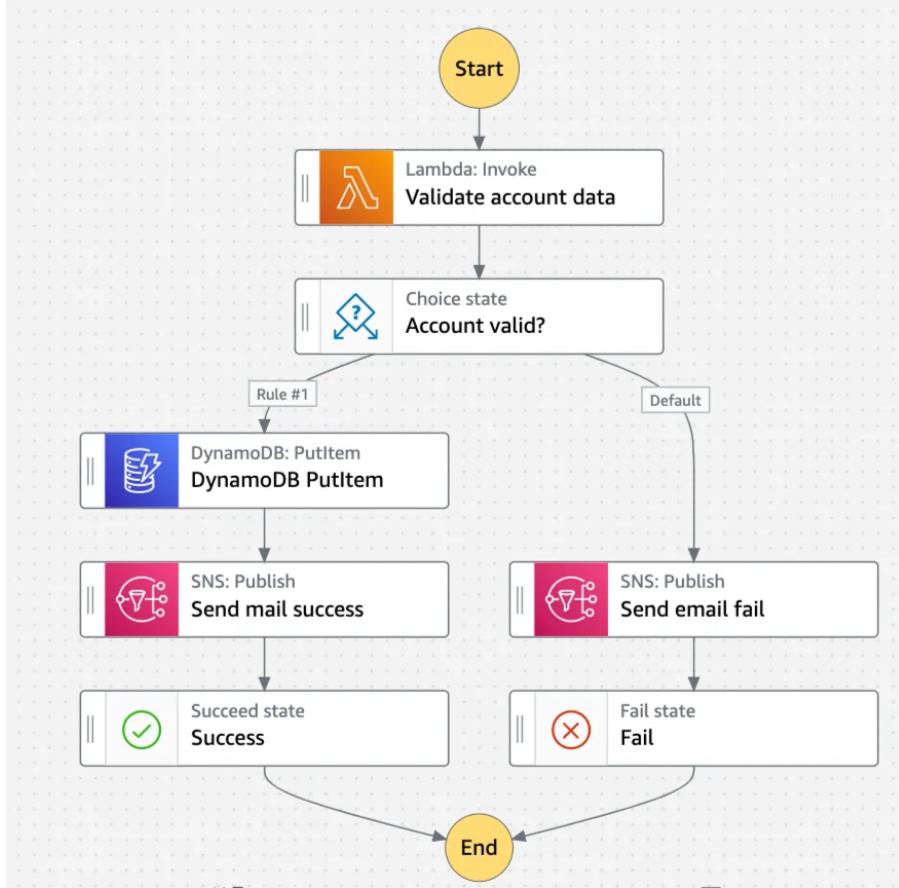
In the ever-evolving landscape of cloud computing, managing and orchestrating distributed applications can be a challenging task. AWS Step Functions, a fully managed service offered by Amazon Web Services (AWS), provides a solution to this challenge by enabling you to coordinate and sequence AWS services, microservices, and serverless functions into scalable workflows. In this article, we’ll explore the key features, benefits, use cases, and best practices associated with AWS Step Functions.
AWS Step Functions: Orchestrating Distributed Applications with Ease
In the ever-evolving landscape of cloud computing, managing and orchestrating distributed applications can be a challenging task. AWS Step Functions, a fully managed service offered by Amazon Web Services (AWS), provides a solution to this challenge by enabling you to coordinate and sequence AWS services, microservices, and serverless functions into scalable workflows. In this article, we’ll explore the key features, benefits, use cases, and best practices associated with AWS Step Functions.
Understanding AWS Step Functions
Overview
AWS Step Functions is a serverless orchestration service that allows you to design, deploy, and execute workflows that integrate with various AWS services. These workflows, known as state machines, help you coordinate multiple AWS resources and microservices, making it easier to build and scale distributed applications.
Key Components
- State Machines: A state machine is the core concept of AWS Step Functions. It defines the sequence of steps (states) to be executed and the conditions for transitioning between states. State machines are defined using Amazon States Language, a JSON-based language.
- States: States represent individual steps in the workflow. These can include AWS Lambda functions, AWS Step Functions’ built-in service integrations, and more. Each state has a specific task or action to perform.
- Execution: When a state machine is executed, it creates an execution instance. An execution instance is a specific run of a state machine. AWS Step Functions tracks the state of each execution, allowing you to monitor and troubleshoot the workflow.
- Service Integrations: AWS Step Functions seamlessly integrates with various AWS services, such as AWS Lambda, AWS Batch, Amazon ECS, and more. This allows you to incorporate these services into your workflows without the need for complex custom code.
Key Features of AWS Step Functions
- Visual Workflow Design
AWS Step Functions provides a visual interface for designing workflows. The visual representation of state machines makes it easy to understand and modify the logic of your application.
- Error Handling
Built-in error handling capabilities allow you to define how the workflow should respond to errors. You can specify retry policies, catch and handle specific error types, and define fallback mechanisms.
- Durable and Reliable Execution
State machines are designed to be durable and reliable. They retain their state, ensuring that workflows can resume from the last known state in case of failures or interruptions.
- Integration with AWS Services
AWS Step Functions seamlessly integrates with various AWS services, including AWS Lambda, AWS Batch, Amazon SNS, Amazon SQS, and more. This integration simplifies the process of coordinating actions across different services.
- Parallel and Sequential Execution
You can define parallel branches and sequential steps within a state machine, enabling you to model complex workflows with ease.
- Timeouts and Retries
AWS Step Functions allows you to set timeouts for states and define retry policies, providing flexibility in handling long-running tasks and transient failures.
Areas of focus
1. Microservices Orchestration
Microservices architecture involves breaking down complex applications into smaller, independent services that can be developed, deployed, and scaled independently. AWS Step Functions is a natural fit for orchestrating microservices, providing a centralized and cohesive way to manage the interactions between various microservices. This use case includes:
- Service Coordination: AWS Step Functions allows you to define the sequence of microservices execution, ensuring that each service is triggered at the right time and in the correct order.
- Error Handling and Retries: Microservices may encounter errors or transient failures. AWS Step Functions’ built-in error handling and retry mechanisms enable you to design robust workflows that can recover from failures gracefully.
- Parallel Execution: In scenarios where microservices can execute concurrently, AWS Step Functions supports parallel execution, optimizing the overall performance of the workflow.
- Scalability: As the number of microservices grows, AWS Step Functions scales with ease, providing a scalable solution for orchestrating complex, distributed systems.
- Data Processing Workflows
Data processing workflows often involve multiple steps, including data ingestion, transformation, and storage. AWS Step Functions streamlines these workflows, offering a reliable and scalable solution for managing data-centric processes. In this use case:
- Ingestion Pipeline: AWS Step Functions can coordinate the ingestion of data from various sources, ensuring that data is efficiently brought into the system.
- Transformation Logic: Define states within the state machine to perform data transformation tasks. This may include data cleansing, enrichment, or any other processing steps required for your specific use case.
- Integration with Data Services: Seamlessly integrate with AWS data services like Amazon S3, Amazon DynamoDB, or AWS Glue to store and retrieve processed data as part of the workflow.
- Event-Driven Processing: Utilize event triggers to initiate data processing workflows in response to specific events, allowing for real-time or near-real-time data processing.
- Business Process Automation
AWS Step Functions serves as a powerful tool for automating complex business processes that involve multiple steps, decisions, or approvals. The visual workflow design simplifies the modeling and modification of intricate business logic. This use case includes:
- Approval Workflows: Define states within the state machine to represent approval steps, where human intervention or decision-making is required. AWS Step Functions can pause the workflow until the necessary approvals are obtained.
- Conditional Logic: Implement conditional branching based on the outcomes of specific states, allowing the workflow to adapt dynamically to different scenarios.
- Audit Trails: Capture and log details of each state execution for auditing purposes, providing visibility into the history of the business process and facilitating compliance.
- Integration with Notification Services: Integrate with services like Amazon SNS to send notifications or alerts at key points in the business process, keeping stakeholders informed.
- Application Integration
AWS Step Functions plays a crucial role in integrating different applications and services, both within the AWS ecosystem and with external APIs. This use case involves:
- Service Orchestration: Orchestrate the flow of data and tasks between various AWS services, ensuring seamless communication and coordination between different components of a distributed application.
- Third-Party API Integration: Integrate with external APIs, allowing your application to interact with third-party services. AWS Step Functions can handle the complexity of API requests, retries, and error handling.
- Event-Driven Architecture: Build event-driven architectures by coordinating the actions of different components in response to events, such as changes in data or the occurrence of specific conditions.
- Cross-Region Integration: If your application spans multiple AWS regions, AWS Step Functions simplifies the coordination of activities across regions, ensuring a cohesive and well-orchestrated operation.
Use Case: Image Processing Pipeline
This scenario involves uploading images to an S3 bucket, triggering a series of processing steps, and then notifying users of the completion. Here’s how you can structure this use case using AWS Step Functions:
1. Start State: Image Upload
- Trigger: An image is uploaded to a designated S3 bucket.
- Action: Start the AWS Step Functions state machine execution.
2. State: Extract Metadata
- Task: Extract metadata (e.g., resolution, format) from the uploaded image.
- Transition: Move to the next state.
3. State: Resize Image
- Task: Use an AWS Lambda function to resize the image to different resolutions.
- Transition: Move to the next state.
4. Parallel State: Apply Filters
- Tasks:
Apply various filters (e.g., grayscale, sepia) to the image in parallel.
- Transition: Move to the next state when all parallel tasks are completed.
5. Choice State: Quality Check
- Task: Check the quality of the processed images.
Transition:
- If image quality meets standards, proceed to the “Generate Thumbnails” state.
- If image quality is below standards, transition to a quality-check-failed handling state.
6. State: Generate Thumbnails
- Task: Generate thumbnails of the processed images.
- Transition: Move to the next state.
7. State: Store Processed Images
- Task: Save the processed images and thumbnails to a different S3 bucket or an image storage service.
- Transition: Move to the next state.
8. State: Notify User
- Task: Send a notification (e.g., SNS message, email) to the user indicating that image processing is complete.
- Transition: End the state machine execution.
9. Error Handling State: Quality Check Failed
- Task: Notify administrators or take corrective actions.
- Transition: End the state machine execution.
{
“Comment”: “Image Processing Pipeline”,
“StartAt”: “ImageUpload”,
“States”: {
“ImageUpload”: {
“Type”: “Pass”,
“Result”: “Image Uploaded”,
“ResultPath”: “$.status”,
“Next”: “ExtractMetadata”
},
“ExtractMetadata”: {
“Type”: “Task”,
“Resource”: “arn:aws:lambda:REGION:ACCOUNT_ID:function:ExtractMetadataFunction”,
“Next”: “ResizeImage”
},
“ResizeImage”: {
“Type”: “Task”,
“Resource”: “arn:aws:lambda:REGION:ACCOUNT_ID:function:ResizeImageFunction”,
“Next”: “ApplyFilters”
},
“ApplyFilters”: {
“Type”: “Parallel”,
“Branches”: [
{
“StartAt”: “ApplyGrayscaleFilter”,
“States”: {
“ApplyGrayscaleFilter”: {
“Type”: “Task”,
“Resource”: “arn:aws:lambda:REGION:ACCOUNT_ID:function:ApplyGrayscaleFilterFunction”,
“End”: true
}
}
},
{
“StartAt”: “ApplySepiaFilter”,
“States”: {
“ApplySepiaFilter”: {
“Type”: “Task”,
“Resource”: “arn:aws:lambda:REGION:ACCOUNT_ID:function:ApplySepiaFilterFunction”,
“End”: true
}
}
}
],
“Next”: “QualityCheck”
},
“QualityCheck”: {
“Type”: “Choice”,
“Choices”: [
{
“Variable”: “$.imageQuality”,
“StringEquals”: “Pass”,
“Next”: “GenerateThumbnails”
},
{
“Variable”: “$.imageQuality”,
“StringEquals”: “Fail”,
“Next”: “QualityCheckFailed”
}
]
},
“GenerateThumbnails”: {
“Type”: “Task”,
“Resource”: “arn:aws:lambda:REGION:ACCOUNT_ID:function:GenerateThumbnailsFunction”,
“Next”: “StoreProcessedImages”
},
“StoreProcessedImages”: {
“Type”: “Task”,
“Resource”: “arn:aws:lambda:REGION:ACCOUNT_ID:function:StoreProcessedImagesFunction”,
“Next”: “NotifyUser”
},
“NotifyUser”: {
“Type”: “Task”,
“Resource”: “arn:aws:sns:REGION:ACCOUNT_ID:ImageProcessingCompleteTopic”,
“End”: true
},
“QualityCheckFailed”: {
“Type”: “Fail”,
“Error”: “QualityCheckFailed”,
“Cause”: “Processed images did not meet quality standards. Please review and re-upload.”,
“End”: true
}
}
}
Explanation:
- The state machine begins with the “ImageUpload” state, triggered by an image being uploaded to S3.
- Each subsequent state represents a specific processing step in the image processing pipeline.
- The “Parallel” state, “ApplyFilters,” applies different filters to the image in parallel.
- The “Choice” state, “QualityCheck,” evaluates the quality of the processed images and transitions accordingly.
- Error-handling state (“QualityCheckFailed”) handles scenarios where the image quality doesn’t meet standards.
- The state machine ends with the “NotifyUser” state, which uses SNS to inform the user that image processing is complete.
While AWS Step Functions offer powerful orchestration capabilities, like any technology, they have certain drawbacks. It’s essential to be aware of these limitations and consider workarounds when designing your workflows. Here are some drawbacks and potential workarounds:
- Execution Duration Limits:
- Drawback: AWS Step Functions have execution duration limits, and the maximum execution time for a state machine is 1 year.
- Workaround: For long-running workflows, consider breaking them into smaller, manageable tasks or workflows. You can use Step Functions to coordinate these smaller workflows.
- State Machine Size Limits:
- Drawback: There are limits on the size of state machines and the number of states within a state machine.
- Workaround: Break down large state machines into modular components. Use Step Functions to coordinate the interaction between these smaller, more focused state machines.
- Limited Customization for Error Messages:
- Drawback: The error messages returned by Step Functions are somewhat limited, which can make debugging challenging.
- Workaround: Implement detailed logging within your Lambda functions or services that are part of the state machine. This way, you can capture additional information and context in your logs for effective debugging.
- Cold Starts with AWS Lambda:
- Drawback: When using AWS Lambda functions as tasks in your state machine, you may encounter cold start latency.
- Workaround: Implement techniques to reduce cold starts, such as keeping Lambda functions warm with regular invocations, using provisioned concurrency, or considering alternate compute services for frequently invoked tasks.
Conclusion
AWS Step Functions empower developers and architects to build scalable and resilient workflows for orchestrating distributed applications. By providing a visual interface, seamless integration with AWS services, and robust error handling capabilities, AWS Step Functions simplifies the complexity of managing distributed systems. Whether you are orchestrating microservices, automating business processes, or processing data at scale, AWS Step Functions is a valuable tool in the AWS serverless ecosystem. As you explore the capabilities of AWS Step Functions, keep in mind the best practices and use cases outlined in this article to maximize the efficiency and reliability of your distributed applications.






Add comment